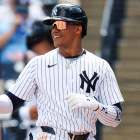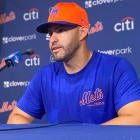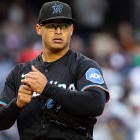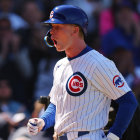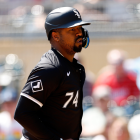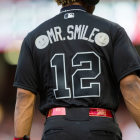The first 78 picks of the 2019 MLB draft have been made. MLB started its 40-round amateur draft with the first round, supplemental first round, competitive balance round A, second round, competitive balance round B, and supplemental second round Monday night during a live broadcast on MLB Network. Here is our pick-by-pick analysis of the first round.
There are two days and more than 1,100 more picks still to come, of course. The draft continues with rounds 3-10 on Tuesday and concludes with rounds 11-40 on Wednesday. While the early rounds get the most attention and understandably so, the later rounds are where organizational depth is built. Success in the later rounds often separates pretenders from contenders.
With the draft set to continue Tuesday, here's a look at the best players still on the board. I think it's important to separate the best available players into two categories, so we'll do exactly that. Let's get to it.
High school players with signability concerns
Every year, without fail, several top high school players price themselves out of the draft. The have strong college commitments and set exorbitant bonus demands. Sometimes they get paid -- the Pirates gave Josh Bell what was then considered a monster bonus ($5 million) to pass on college in 2011 -- but usually they don't, and they go to school.
At this point, one of two things will happen with the players in this section. Either they won't get drafted (or will get drafted very late) and wind up in school, or they'll get drafted right away Tuesday after working out a deal overnight. That is technically against the rules! But it happens all the time. Teams will work to lock in a number so they can plan accordingly. Here are the high-priced high schoolers still on the board.
RHP Matthew Allan, Seminole HS (Florida): Allan was the top high school pitcher in the draft class. He has everything teams want in a pitching prospect, including power stuff (fastball, curveball, changeup), good control, and size (6-foot-3 and 210 lbs.). Allan is committed to Florida and has reportedly set a $4 million asking price. Among the players in this section, I think he's the most signable, but it's still likely he winds up on campus at this point.
LHP Hunter Barco, The Bolles School (Florida): The best high school lefty in a draft class short on power arms, Barco shows three above-average pitches and good velocity. His lower arm slot (think Madison Bumgarner) creates command issues at times, though experience can help fix that. Barco is committed to Florida, an excellent player development program, and should he wind up in school, he figures to come out as a possible top-10 pick in three years.
3B Tyler Callihan, Providence School (Florida): There was quite a bit of first round buzz for Callihan in the days leading up to the draft. He's a good pure hitter from the left side and a sneaky great athlete given his size (5-foot-11 and 210 lbs.). Callihan is an older high schooler (turns 19 on June 22) and the track record of older high schoolers in pro ball isn't good. They tend to slip on draft day and that's exactly what is happening with Callihan. He's a South Carolina commit.
OF Maurice Hampton, Memphis University School (Tennessee): Hampton and Kyler Murray have something in common: They were both All-Americans in football and baseball. As you'd expect, Hampton is a great athlete with outstanding tools, but he is raw on a baseball field. He's struggled against top competition in showcase events. Hampton is committed to LSU, where he's slated to play baseball and football. A since deleted tweet sent out Monday night indicated he is planning to go to school.
RHP Jack Leiter, Delbarton HS (New Jersey): Jack is the son of longtime big leaguer Al Leiter and he pitches like the son of a former MLB star. He's exceptionally advanced for a high schooler with a deep arsenal, excellent command, and very good pitching know-how. Leiter knows how to set hitters up and exploit weaknesses. His fastball is a little short right now (90-92 mph), but, after three years at Vanderbilt, he could be a No. 1 pick candidate. Leiter is reportedly only willing to sign with the Yankees or Mets and it would take big money. At this point, it is all but certain he's going to school.
1B/LHP Spencer Jones, La Costa Canyon HS (California): A broken elbow put Jones on the shelf all spring and took him out of the first round. He is a legitimate two-way prospect as a power-hitting first baseman with the athleticism to play the outfield, and a hard-throwing southpaw with a very good curveball. Jones is gigantic (6-foot-7 and 205 lbs.) and offers quite a bit of upside on both sides of the ball. Teams haven't seen him this spring because of the injury, making it likely he'll wind up at Vanderbilt. What a shame. Jones is a fascinating prospect.
Other best available players
The high schoolers with signability questions will dominate any "best available players" list you see Tuesday and Wednesday. The following 10 players are the best available guys who are expected to actually, you know, sign.
RHP Osmond Bryce, Jenks HS (Oklahoma): Bryce is a legitimate two-way prospect as a shortstop and right-handed pitcher. The consensus is he has a better long-term future on the mound though, where he features low-90s gas and a promising slider. He's a great athlete with power in his bat and strong defensive chops. Bryce is committed to Oklahoma State and would play both ways for the Cowboys. That said, he's generally considered signable.
LHP Matt Cronin, Arkansas: Thanks to a low-90s heater and a hammer curveball, Cronin should be among the first 2019 draftees to reach the big leagues. He's a career reliever with strong spin rates, a herky jerky delivery, and a bulldog mentality. An analytics savvy club figures to take Cronin early Tuesday and immediately begin grooming him for a potential big league debut as soon as early next year.
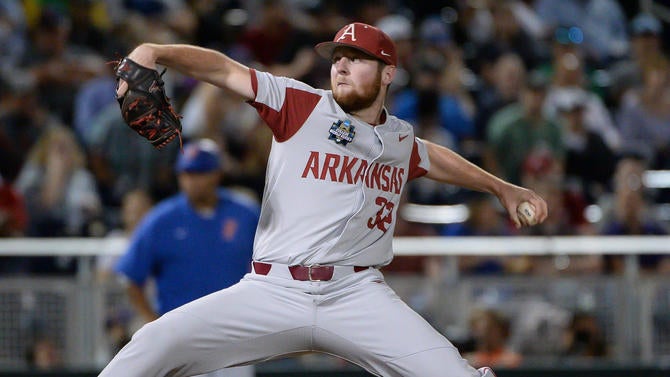
C Ethan Hearn, Mobile Christian HS (Alabama): Hearn is, rather easily, the best high school catcher in the 2019 draft class. He has power and a very good arm, though his receiving needs improvement as does his approach at the plate. Hearn is committed to Mississippi State, but catchers are always drafted higher than the various scouting publication rankings would lead you to expect, so some club figures to draft Hearn early Tuesday and meet his asking price, whatever it is.
SS Will Holland, Auburn. A standout performance with wood bats in the prestigious Cape Cod League last summer put Holland on the draft map. He's a power over hit tool guy, and has unrefined defensive tools at shortstop. The athleticism and power potential is tantalizing. Holland will need some help ironing out his swing and becoming more consistent in the field, however.
RHP Jack Kochanowicz, Harrison HS (Pennsylvania): Kochanowicz is long and lanky (6-foot-6 and 210 lbs.) and quite unrefined, which is not surprising for a kid from a cold weather state. He already sits in the mid-90s though, and his curveball features the high spin rate teams love. Kochanowicz is committed to Virginia and has the tools to develop into a top 15 pick over the next three years. The expectation is he'll go on Tuesday and take the money instead.
3B Drew Mendoza, Florida State: A lefty hitter with huge power and some swing-and-miss in his game, Mendoza has a risky offensive profile and not quiet enough defensive value to make up for it. Whichever team takes him on Tuesday will be betting on their player development staff's ability to help Mendoza make more consistent contact and/or improve his defense at third base.
C Kyle McCann, Georgia Tech: I expected McCann to come off the board Monday because teams always aggressively pursue catchers. Quality catchers are hard to find and teams load up on them on draft day. McCann has big power from the left side, and whichever team drafts him will hope he improves his defense after being stuck backing up Joey Bart, the No. 2 pick in 2018, as a freshman and sophomore.
RHP Ryan Pepiot, Indiana: Pepiot is the quintessential Day 2 college pitching prospect. He's been working as a starter with good if not unspectacular stuff for three years now, and he has an out-pitch in his fading changeup. Pepiot slings the ball from a lower arm slot, which leads to control and platoon issues. Still, guys like this tend to have success in pro ball and provide big league value, even if it's only as a middle reliever.
LHP Erik Miller, Stanford: There was some last minute first round buzz involving Miller over the weekend. He remains on the board, however, and is the best available college pitcher in a draft that was light on college arms to begin with. Miller is huge (6-foot-5 and 240 lbs.) with a mid-90s fastball and a slider and changeup that both look like out-pitches on his best days. Control and delivery concerns hold him back. Expect Miller to be among the first players taken Tuesday.
LHP Graeme Stinson, Duke: A hamstring injury sabotaged Stinson's draft stock this spring. His stuff and control backed up following the injury, knocking him down draft boards. When right, the massive (6-foot-5 and 260 lbs.) southpaw operates with a mid-90s fastball and one of the best sliders in the draft class. Stinson may only be a reliever long-term, but the raw tools are there for him to be a very good one.
















